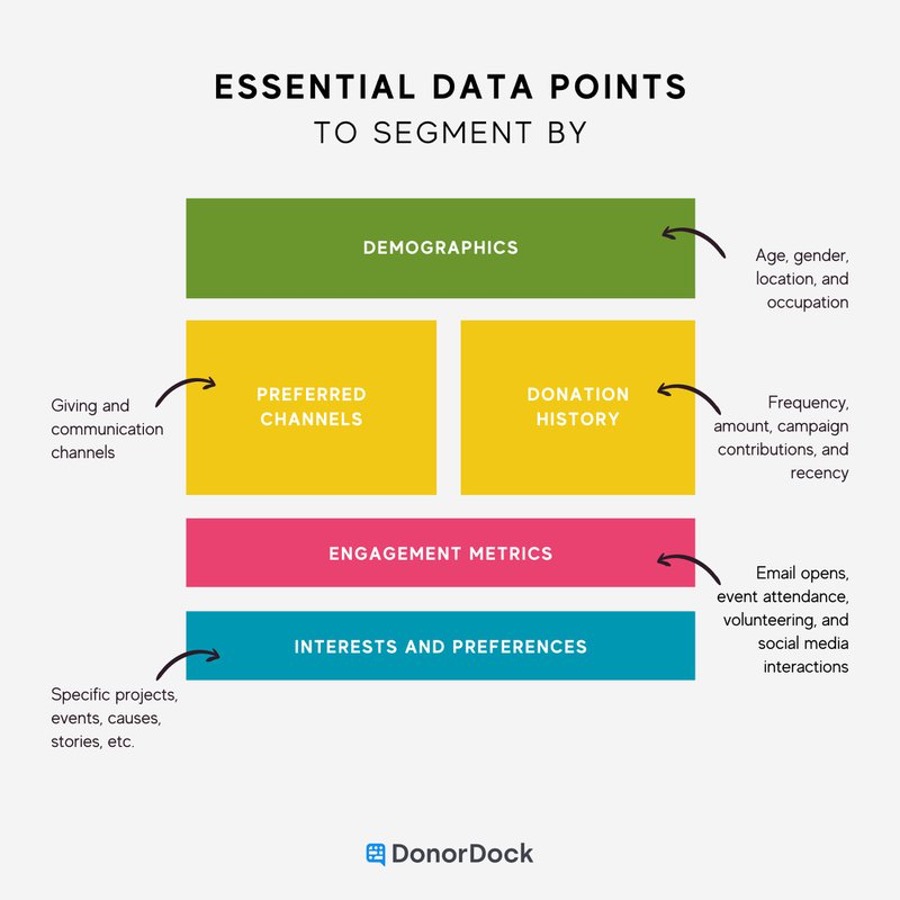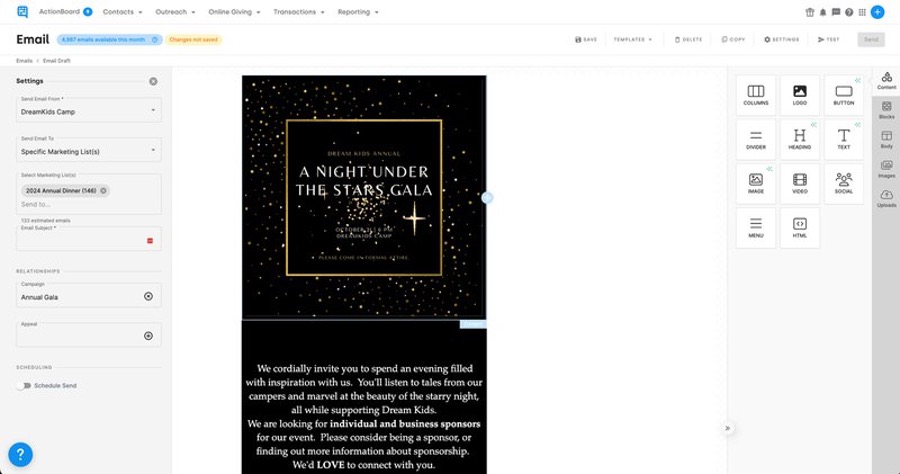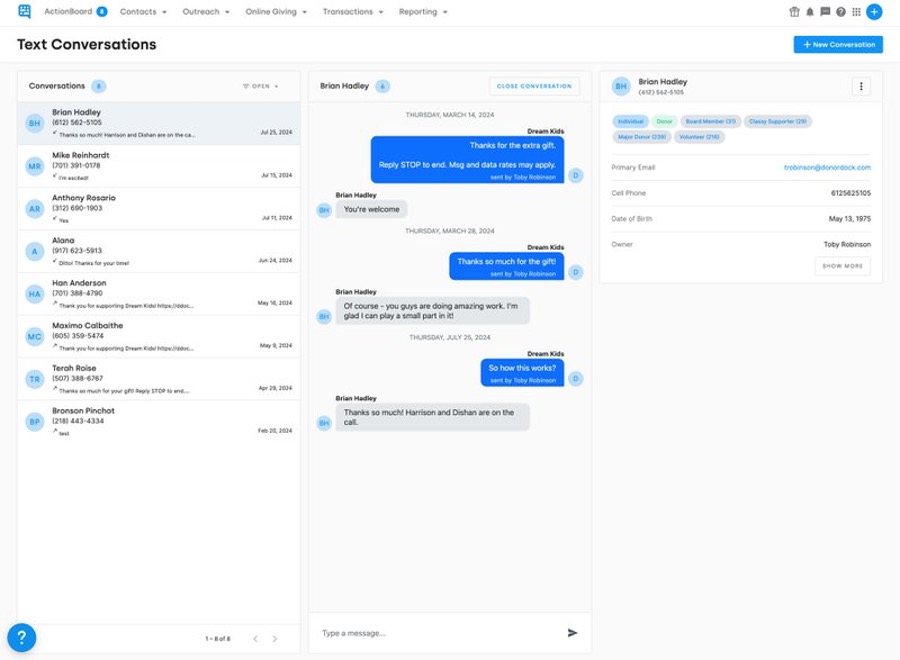You’re tirelessly working to grow your nonprofit’s impact, nurture your community, and raise funds—all while managing all the other day-to-day tasks. With so much on your plate, streamlining your donor outreach is not just good—it’s essential!
Imagine having the power to tailor your mass communication, so that each donor feels personally connected to your cause. This is the magic of donor data. By using the insights hidden in your donor information, you can fine-tune your marketing strategies.
The result?
- More engaged supporters
- More effective campaigns
- More funds raised
all with less effort.
Let’s find out how to turn donor data into a powerful tool for your nonprofit’s success!
The Importance of Segmentation
To truly engage supporters, a one-size-fits-all approach doesn’t work. Just as you wouldn’t talk to your boss the same way you would a friend, you shouldn’t communicate with all donors in the same way.
Donor segmentation is the process of dividing a nonprofit’s donor base into distinct groups based on shared characteristics or behaviors.
While it might seem like a time-consuming task, doing the work upfront saves you time in the future.
Plus, understanding donor segments allows you to craft personalized communication without needing to write individual messages for each donor. Personalized interactions strengthen donor relationships, leading to increased donor engagement and retention!
Impact on Retention Rates
Effective segmentation goes beyond grouping donors by shared traits; it provides actionable insights to boost donor retention.
While retaining donors is far more cost-effective than acquiring new donors, nonprofits face a challenge as only 40-45% of donors typically continue their support.
Tailoring messages to different donor segments, such as first-time donors versus recurring donors, is key to increasing engagement and retention. Personalized communication that speaks directly to the interests and behaviors of each donor group not only fosters a deeper connection but also encourages continued support, ultimately driving the success of your nonprofit.
By segmenting your marketing channels based on detailed donor data, you communicate more effectively and personally. This treasure trove of information about donor behavior and preferences turns generic outreach into powerful, targeted communication.
Using Donor Data to Create Segments
Leveraging donor data is crucial for creating targeted and effective communication strategies. By segmenting donors based on key data points, nonprofits can tailor their outreach to meet the specific needs and preferences of different donor groups.

Here are some essential data points to consider:
- Demographics: Age, gender, location, and occupation can influence donation behavior. Tailoring messages to these demographic segments helps guarantee relevance.
- Donation history: Segmenting by donation frequency, amount, and recency helps identify loyal donors and potential major donors. You can also segment around specific campaigns they support, which provides insights into their motivations. This allows for personalized appeals and recognition.
- Preferred donation and communication channels: Knowing donors’ preferred methods of giving (online donations, mailed checks, text-to-give) ensures a convenient donation process. Likewise, understanding how donors prefer to be contacted (email, phone, text, mail, social media) helps them see your communication. Ask donors directly about their preferences.
- Engagement: Engagement metrics like event attendance, volunteering, email opens, and social media interactions highlight active and passive supporters. Engaging active supporters with targeted campaigns fosters deeper connections.
- Interests and preferences: Understanding donors’ interests and the causes they support helps with personalized content delivery. Sending targeted messages about specific projects or events can resonate more with these segments.
Choosing the Right Marketing Channels
Tailoring Communication
By understanding these personas, a nonprofit can adjust its marketing strategies to meet the needs of each group. For instance, sending email updates to the donor persona and sharing volunteer opportunities on social media for the volunteer persona ensures that the right messages reach the right people.
Communication channels are the mediums through which people prefer to connect and receive information. Just as some people enjoy scrolling through TikTok and Instagram in their free time, others may prefer a letter in the mail or a phone call to brighten their day. Recognizing how your donors like to communicate is key to an effective nonprofit marketing strategy, as different people have different preferences based on their personalities, life stages, and interests.
Common Communication Channels for Nonprofits
Email Marketing

Email remains a powerful tool for reaching donors. Widely used for sending newsletters, event invitations, and donation requests. Email allows for personalized and detailed communication. Subject lines and content tailored to each segment can significantly improve open and click-through rates.
Plus, it’s cost-effective and easy to track engagement!
Social Media Platforms
Platforms like Facebook, Instagram, TikTok, and Twitter are ideal for reaching a broad audience and providing real-time updates.
By creating targeted ads and posts that cater to the specific interests and behaviors of each group, you can foster deeper connections and drive higher interaction.
Engaging content, especially visual and interactive posts, boosts engagement and sharing. This, in turn, brings more awareness and attention to your nonprofit! Social media allows your organization to stay relevant and top-of-mind, enhancing your overall communication strategy.
Direct Mail Campaigns
Despite the dominance of digital channels, direct mail is still valuable! Segment your mailing list to send personalized letters and appeals, especially since older demographics often prefer snail mail over social media posts or emails. Direct mail adds a personal touch and can be more memorable, making it ideal for detailed reports or heartfelt messages.
Additionally, an intentional hand-written thank you often means a lot to donors. If you’re limited on time, segment handwritten thank yous to major or recurring donors. They’re sure to make a lasting impression!
Phone Calls
Phone calls are a direct and personal way to connect with donors. A phone call offers an opportunity for immediate feedback and interaction. While they are effective for building relationships, they take more time than any other marketing channel.
To maximize the impact of each phone call, choose the right donor segments. Focus on reaching out to major donors, volunteers, and those who have shown high engagement with your organization. These individuals are more likely to appreciate the personal touch of a phone call.
Additionally, consider calling lapsed donors to rekindle their interest and support. Prioritizing these segments guarantees that your time yields the best outcomes in terms of donor retention and building community.
Text Messages

Text messages are a quick and effective way to connect with donors. Texts have a high open and response rate and allow for immediate communication and engagement. While less personal than phone calls, they are efficient and can reach a large audience swiftly.
Focus on reaching out to younger donors who are more likely to prefer texts to phone calls or emails, as well as event attendees who may need timely updates or reminders. Texts also work great to thank recent donors or remind recurring donors of upcoming giving.
Website Personalization
It’s easy to forget that your nonprofit’s website is another channel of communication, but it’s often one of the first places donors go to get information. Use your donor data to personalize and adjust your website content. Share tailored messages and relevant stories based on your visitor data.
A personalized website experience can boost engagement and conversions.
Measuring Success: Your Segmentation Strategies at Work
To make sure your donor segmentation strategies are effective, it’s important to measure success regularly. Here’s how to keep your campaigns on track.
Track and Analyze Metrics
Regularly monitor the performance of your segmented campaigns. Key metrics to track include open rates, click-through rates, conversion rates, and overall donation growth. Analyzing this data provides insights into what’s working and what needs adjustment. Use these insights to refine your segmentation strategies and enhance future campaigns.
Using a Nonprofit CRM that consolidates all your donor, donation, and communication data in one place streamlines your donor outreach. By centralizing this information, making data-driven decisions becomes effortless, empowering your nonprofit to operate more efficiently and effectively.
Adjust and Optimize
Based on your analysis, make adjustments to your segmentation criteria and marketing approaches. Conduct A/B testing to compare different strategies and identify the most effective ones. Continuous optimization helps your strategies stay effective and aligned with donor preferences.
Conclusion
The power of donor data is transformative for any nonprofit striving to make a lasting impact. Through effective segmentation, you turn generic outreach into meaningful, personalized communication that resonates deeply with your supporters.
By understanding your donors’ demographics, preferences, and behaviors, you create the foundation for targeted, compelling messaging that speaks directly to their interests and motivations.
Moreover, by using the right marketing channels—whether it’s personalized emails, engaging social media posts, heartfelt direct mail, or timely text messages—you can ensure that your communications are both effective and efficient.
Regularly measuring and optimizing your strategies based on performance data ensures you’re making data-driven decisions. By doing so, you’ll not only streamline your own operations, but you’ll also better engage your community.
About the Author
A nonprofit CRM designed with small nonprofits in mind, DonorDock turns static data into actionable donor engagement strategies, so that you can focus on what matters most – your mission.
With DonorDock CRM, you’ll finally have one reliable place to track data, accept donations, and reach out to donors. Have peace of mind knowing that donor engagement opportunities aren’t falling through the cracks.
DonorDock is rated the #1 Easiest to Use Nonprofit CRM, and it will help you feel less busy, so you can focus on the work you’re passionate about.






